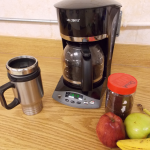by Kristin Jackson | Apr 3, 2013

Could this be one of the germiest places in your home?
In 2011, NSF International, an independent, not-for-profit organization, conducted a study with 22 families and analyzed 30 items in their homes. One item that disappointingly made NSF International’s list of the “Top Ten Germiest Places in the Home” was the coffee reservoir. This could be sad news for the approximately 239 million individuals, or 83 percent of American adults, who drank coffee in the US in 2012 (National Coffee Association).
Perk up, coffee drinkers. The good news is the solution is easy: simply clean your coffee maker according to the manufacturer’s instructions and then sanitize. Cleaning will wash/wipe away many bacteria, but sanitizing, according to the National Restaurant Association, is the process of reducing the number of microorganisms that are on a properly cleaned surface to a safe level.
You can sanitize your coffee maker using vinegar. Vinegar can be an effective sanitizing agent for your coffee maker if:
- you use white distilled vinegar (at least 5% acidity).
- the vinegar remains undiluted.
- you heat the vinegar to 130 degrees Fahrenheit or 55 degrees Celsius.
- you leave the heated vinegar on the surface for at least one minute.
 Once the vinegar has remained in the coffee reservoir for at least one minute, you can run the vinegar through the coffee maker. In order to remove the vinegar odor and taste, you may want to follow with a few cycles of clean water. Remember, the water must be clean and you should air dry the reservoir or use a clean paper towel to dry.
Once the vinegar has remained in the coffee reservoir for at least one minute, you can run the vinegar through the coffee maker. In order to remove the vinegar odor and taste, you may want to follow with a few cycles of clean water. Remember, the water must be clean and you should air dry the reservoir or use a clean paper towel to dry.
Now that you know how simple the process is, you are probably wondering how frequently you should take on the task. According to the National Restaurant Association, you should you sanitize:
- after each use
- anytime as necessary
- after 4 hours in use
So now you see how simple it is to keep the coffee maker from being one of the germiest places in your home. To find out other ways to clean and sanitize your kitchen, visit http://edis.ifas.ufl.edu/pdffiles/FY/FY128000.pdf and read Cleaning and Sanitizing the Kitchen: Using Inexpensive Household Food-safe Products. If you have any additional questions or concerns, you can contact your local Family and Consumer Sciences Agent (http://solutionsforyourlife.ufl.edu/map/ ).
References:
NSF International (2004). Top Ten Germiest Places in the Home. Retrieved 26 March 2013 from http://www.nsf.org/consumer/newsroom/fact_top10_germiest_places.asp
ServSafe Essentials 6th Edition. 2011. ISBN-13: 978-0133075687
Janet Buffer, Lydia Medeiros, Mary Schroeder, Patricia Kendall, Jeff LeJeune, and John Sofos; adapted by Amy Simonne for use in Florida with permission. FCS8 OH 2010. Cleaning and Sanitizing the Kitchen: Using Inexpensive Household Food-safe Products. Retrieved 26 March 2013 from http://edis.ifas.ufl.edu/pdffiles/FY/FY128000.pdf
Yang, H., Kendall, P., Medeiros, L., Sofos, J. (2009) Inactivation of Listeria monocytogenes, Escherichia coli O157:H7, and Salmonella Typhimurium with compounds available in households. J. Food Prot. 72(6); 1201-1208
by Judy Corbus | Mar 25, 2013

Dye one set of eggs for hiding and another set for eating.
If an Easter egg hunt is on your calendar for the holiday weekend, follow these tips for safe, quality hard cooked eggs. Dr. Amy Simonne, University of Florida/IFAS Food Safety Specialist, recommends choosing Grade A or AA eggs with clean, uncracked shells. Store eggs in the carton in the main compartment of the refrigerator, not the door, to maintain freshness. It is not necessary to wash eggs before coloring but inspect and discard any that are unclean, cracked, broken, or leaking.
To prepare hard cooked eggs, place eggs in a single layer in a saucepan. Add enough tap water to cover eggs by at least one inch. Cover and quickly bring just to boiling. Turn off heat and, if necessary, remove the pan from the burner to prevent further boiling. Let eggs stand, covered, in the hot water about 18 minutes for extra-large eggs, 15 minutes for large eggs, and 12 minutes for medium eggs. Immediately run cold water over eggs or place them in iced water until completely cooked. To remove shell, crackle it by tapping gently all over. Roll egg between hands to loosen shell. Peel, starting at the large end. Hold egg under running cold water or dip in a bowl of water to help ease off the shell. Eggshells usually come off much more easily, without tearing the whites, when they are in small pieces rather than large chunks. Very fresh eggs may be difficult to peel. The fresher the egg, the more the shell membrane clings to the shell. For best results, buy and refrigerate eggs seven to ten days before hard cooking. This brief “breather” allows the eggs to take in air, which helps separate the membrane from the shell.
When coloring eggs, use only food-grade dyes or natural color from vegetables such as beets, cranberries, and blueberries. Hard-cooked eggs will keep in the refrigerator for one week. Like leftover turkey at Thanksgiving, colored eggs are great for sandwiches, either sliced or in egg salad.
Since eggs receive a lot of handling during a hunt, cracks are common. This allows bacteria from hands and the hiding places to seep through the shell, contaminating the inside. After the hunt, discard any with cracked shells. Discard also any eggs that have been out of the refrigerator for more than two hours. Re-refrigerate the “found” eggs until they are eaten. To reduce the risk of foodborne illness, consider coloring one batch for hunting and another for eating. An even safer option is to use plastic eggs for your hunt. For more fun, add a candy or trinket surprise inside each egg.
Be careful when preparing dishes calling for raw eggs. Many recipes for bunny-shaped cakes call for using a raw egg white in the frosting. However, this poses a risk for salmonella food poisoning. To be safe, use a frosting recipe that uses hot syrup and egg white. If the egg white mixture reaches 160 degrees F on a thermometer, it should be safe. You also may be able to use a pasteurized powdered meringue available where cake decorating supplies are sold.
Sources: FAR8702 Egg Safety, Dr. A. Simonne, University of Florida/IFAS Extension.
Traditional Spring Food: Its History and Safe Handling Today, L. Fox, USDA.
Egg Tips for Easter, Muriel Turner, University of Florida/IFAS Extension.
by Judy Corbus | Apr 6, 2012

Dye one set of eggs for hiding and another set for eating to reduce foodborne illness risk
Easter Egg coloring can be a lot of fun for the whole family, but it is important to remember to practice food safety. “Based on USDA’s statistics, the average consumer would encounter a contaminated egg only once in 42 years. And then, that egg would have to be time- and temperature-abused to contribute to a health problem,” (Egg Nutrition Center,1999). Time and temperature abuse is caused when food is not held or stored at the right temperature to kill viruses or bacteria. As consumers, we may purchase food that is safe, but it can become unsafe based on what we do with it after we buy it. From the moment our eggs leave the store’s refrigerated case, the timer is on. Some tips for keeping your eggs safe and avoiding foodborne illness on the way home include picking up refrigerated items last, bringing a cooler if you have to travel a while before you will return home, and immediately refrigerating items once you arrive home.
The USDA also recommends the following tips to help keep our eggs safe and avoid foodborne illness:
• Don’t take eggs out of the carton to put them in the refrigerator — the carton protects them. Keep the eggs in the coldest part of the refrigerator — not on the door.
• Raw shell eggs in the carton can stay in your refrigerator for three to five weeks from the purchase date. Although the “Sell-By” date might pass during that time, the eggs are still safe to use. (The date is not required by federal law, but some states may require it.)
• Always wash your hands with warm water and soap before and after handling raw eggs. To avoid cross-contamination, you should also wash forks, knives, spoons, and all counters and other surfaces that touch the eggs with hot water and soap.
• Don’t keep raw or cooked eggs out of the refrigerator for more than two hours.
• Egg dishes such as deviled eggs or egg salad should be used within 3 to 4 days.
In addition to carefully handling Easter Eggs, consider using two sets of eggs – one set for hiding and one for eating. Color extra eggs for the Easter Egg hunt or for decoration but set aside eggs in the refrigerator just for eating. Another option is to reserve the dyed Easter Eggs for eating and use plastic eggs for hiding. These can be filled with wrapped candy or other treats so they still make awesome finds!
 Once the vinegar has remained in the coffee reservoir for at least one minute, you can run the vinegar through the coffee maker. In order to remove the vinegar odor and taste, you may want to follow with a few cycles of clean water. Remember, the water must be clean and you should air dry the reservoir or use a clean paper towel to dry.
Once the vinegar has remained in the coffee reservoir for at least one minute, you can run the vinegar through the coffee maker. In order to remove the vinegar odor and taste, you may want to follow with a few cycles of clean water. Remember, the water must be clean and you should air dry the reservoir or use a clean paper towel to dry.

